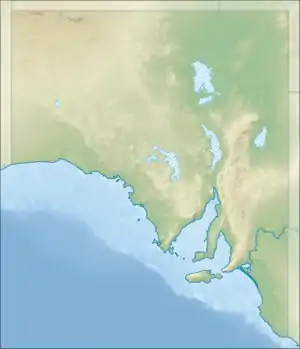Grass Tree Conservation Park
Grass Tree Conservation Park is a protected area in the Australian state of South Australia located in the state's Limestone Coast in the gazetted locality of Cadgee about 17 kilometres (11 mi) north of the town centre in Naracoorte.[2][5]
| Grass Tree Conservation Park South Australia | |
|---|---|
 Grass Tree Conservation Park | |
| Nearest town or city | Naracoorte[2] |
| Coordinates | 36°48′29″S 140°41′31″E |
| Established | 17 August 1972[3] |
| Area | 16 hectares (40 acres)[4] |
| Visitation | ‘very little visitor use’ (in 1992)[5] |
| Managing authorities | Department for Environment and Water |
| See also | Protected areas of South Australia |
The conservation park occupies land in section 451 of the cadastral unit of the Hundred of Hynam on the southern side of Boddingtons West Road.[2][5] It was proclaimed under the National Parks and Wildlife Act 1972 on 17 August 1972 for the purpose of protecting a stand of grass tree.[5][3]
While the crown land on which the conservation park was established had not been cleared for agricultural use, evidence of disturbance of the understorey in an open forest area and the associated presence of introduced grasses suggests that the land was “previously grazed by domestic livestock.”[5][3]
In 1992, the conservation park was described as follows. Firstly, the soils within the conservation park are reported as being located in the “Naracoorte Environmental Association” which is “characterised by calcarenite dune ridges overlain by dunes or sheets of mobile sand.” Specifically, the majority of the soils in the conservation park are “deep, acid, bleached sands with a yellow-grey B horizon” while a minority consist of “shallower alkaline sandy soils of a reddish colour.”[5] Secondly, land within the conservation park supported the following “three vegetation associations:”
- a “low woodland “ of brown stringybark “associated with sandy soils of the stranded dune systems of the West Naracoorte Range,”
- an “open forest - low open forest” of pink gum associated with a stoney limestone rise in the central part” of the conservation park and “an understorey generally consisting of introduced grasses and pasture weeds such as Cape weed (Arctotheca calendula);” and
- a ”small area” of “open forest” of South Australian blue gum in the south-east in the conservation park's south-east with “an understorey of grass trees, Austral bracken (pteridium esculentum), and rice flower (Pimelea sp.).”
As of 1992, the conservation park had “very little visitor use.” There were no facilities being provided for visitors apart from “boundary access tracks” of 5 metres (16 ft) width to its west, south and east boundaries.[5]
The conservation park is classified as an IUCN Category III protected area.[1]
See also
References
- "Terrestrial Protected Areas of South Australia (refer 'DETAIL' tab )". CAPAD 2016. Australian Government, Department of the Environment (DoE). 2016. Retrieved 21 February 2018.
- "Search result(s) for Grass Tree Conservation Park (Record No. SA0027448) with the following layers being selected - "Parcel labels", "Suburbs and Localities", "Hundreds", "Place names (gazetteer)" and "Road labels"". Property Location Browser. Government of South Australia. Retrieved 16 January 2017.
- "NATIONAL PARKS AND WILDLIFE ACT, 1972: HUNDRED OF HYNAM—GRASS TREE CONSERVATION PARK CONSTITUTED" (PDF). The South Australian Government Gazette. Government of South Australia: 1171. 17 August 1972. Retrieved 16 January 2017.
- "Protected Areas Information System - reserve list (as of 11 July 2016)" (PDF). Department of Environment Water and Natural Resources. 11 July 2016. Retrieved 14 July 2016.
- South Australia. National Parks and Wildlife Service. South East District; Sutherland, Andrea; South Australia. National Parks and Wildlife Service (1992), Small parks of the upper South East management plans, South East, South Australia (PDF), Dept. of Environment and Planning, pp. 14–16, ISBN 978-0-7308-2665-1